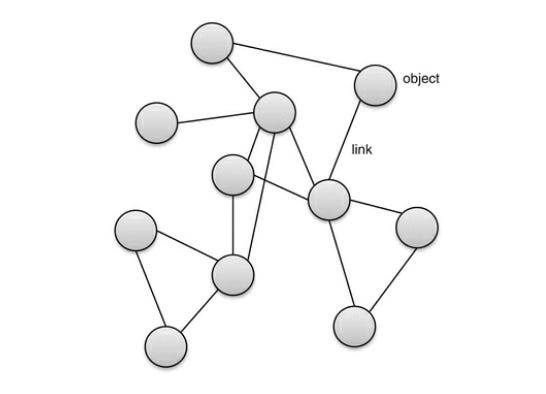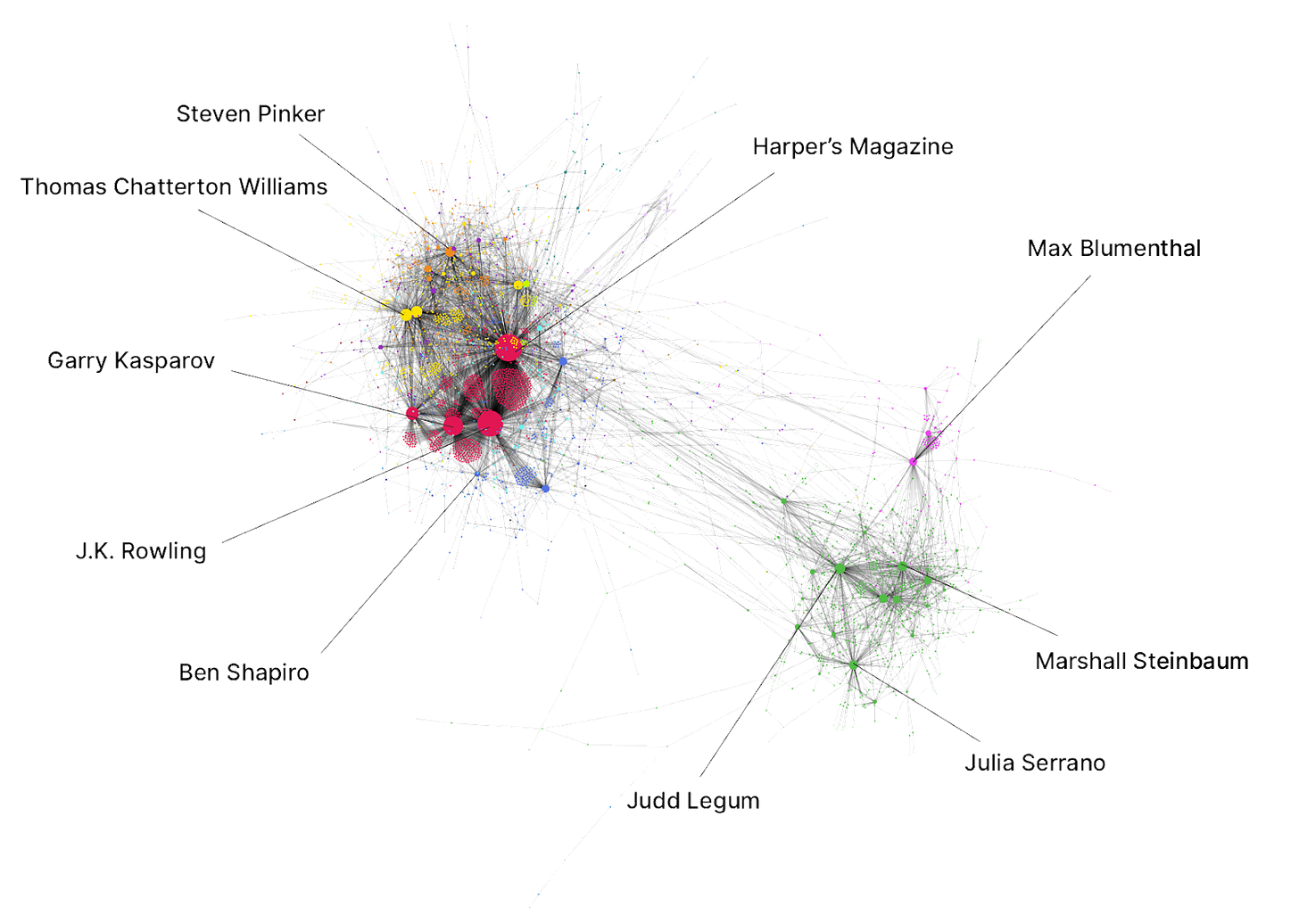The third principle of systems science states that systems can be represented abstractly as networks of relations among components. Any system we’re interested in can be modeled as a network, and it is often useful to do so.
Last week’s piece on process and hierarchy inspired us to think deeply about how systems organize themselves and do work. This week we’ll introduce some powerful tools for thinking deeply about the connections and interactions within systems. It is common to hear people make vague statements about how “everything is connected”; the language of networks and tools of network science allow us to see and measure the ways in which this is literally true.
In this article I’ll describe what networks are and define a few key terms needed to understand them. Next I’ll provide several examples of how modeling systems as networks enables new ways of understanding ourselves and our world.
What is a Network?
Nodes and Edges
A network is a set of components connected by links, also referred to as nodes and edges. In the image below, the circular nodes represent objects, while the lines between them represent the connections they have to one another.
Mobus, George E.; Kalton, Michael C.. Principles of Systems Science (Understanding Complex Systems) (p. 139). Springer New York. Kindle Edition.
This collection of interconnected nodes could represent anything from a group of friends, to neurons in the brain, or a set of countries.
A hub is a special type of node that is strongly connected to many other nodes. Because it is so well connected, it acts as a bridge between various nodes. New York, London, and Singapore are global financial hubs. These locations house institutions and organizations which bridge the financial and economic activities of cities and countries across the globe. A significant portion of global economic activity flows through only a small fraction of its cities.
Mobus, George E.; Kalton, Michael C.. Principles of Systems Science (Understanding Complex Systems) (p. 23). Springer New York. Kindle Edition.
Communities
A community (or “cluster”) is a group of nodes within a network which have a higher number of connections between the nodes than it does with the rest of the network. We can imagine the clusters below as representing cliques of friends, departments within a corporation, or fans of different local sports teams.
Mobus, George E.; Kalton, Michael C.. Principles of Systems Science (Understanding Complex Systems) (p. 152). Springer New York. Kindle Edition.
Centrality
Centrality is a measure of how important a given node is in a network. The graph below depicts a network of friends. Friend “A” has friendships with 7 other people, so we could say it has a centrality score of 7. Friend “G” has a centrality score of 5, and C has one of 4. If we wanted information to spread quickly throughout this network, it would be strategic to target these key nodes. For instance, marketers who are responsible for promoting new products on social media should focus on nodes with high centrality within a certain community, thus ensuring awareness of their products reaches a wide audience.
Why Networks Matter
Networks are everywhere. We are increasingly becoming a networked society, one which is connected through the use of networks which allow for instantaneous communication and spread of information. In order to benefit from rather than be overwhelmed by these higher levels of connectivity, we will require network literacy—knowledge of how networks can be used for discovery and decision-making.
The language and tools of network science give us powerful new ways to think about our social lives, the technology we create, and public discourse around important topics.
Effective Networking
Marissa King is a sociologist who describes three different ways in which people approach social networking in her book Social Chemistry. Her research demonstrates that when it comes to networking, it's not the size of your network that matters, it's the structure.
Expansionists are people who have large networks. They are popular and good at working rooms. However it can be hard for them to maintain social ties and leverage those ties to create value.
Brokers are people who create value by bringing together typically disconnected parties from different social worlds. Their networks have huge information sharing benefits and are highly innovative.
Conveners are people who build dense networks in which their friends also become friends. This type of network has large trust and reputational benefits.
King’s work shows how understanding the structure of your social network can improve the quality of your personal life. Knowing what sort of social network relations you are entangled in allows you to adapt and modify your network as necessary.
Her network structures could also be generalized to applications outside of the social realm. In analyzing social media, for instance, YouTube can be understood as an expansionist platform, enabling an audience to gather around a central figure. LinkedIn, on the other hand, acts as a broker between various businesses, and Twitter is for conveners as it encourages retweeting and sharing information. Understanding this allows us to more readily make sense of the particular social dynamics that emerge out of each platform, and is something that should be considered as we enter into a more networked future.
Visualizing Growth in Crypto
One of the first network visualizations that really made an impression on me was a depiction of the Bitcoin network in 2016 that was presented in an academic paper. It was a prime example of a picture being worth a thousand words.
A network graph of the Bitcoin network in which nodes represent user addresses and edges represent transactions between users –The Evolution of the Bitcoin Economy: Extracting and Analyzing the Network of Payment Relationships P.31
If you aren’t interested in crypto then this is probably a meaningless blob. But for me, as a young crypto enthusiast, it was an eye-opening depiction of the state of the technology. I immediately started to grasp some of the new possibilities that emerge when a financial system is built on a transparent digital public ledger. Greater public oversight over core economic infrastructure, more rapid discovery of vulnerabilities in important financial systems, and increased capacity for individual citizen journalists to monitor suspicious activity, to name just a few. Additionally, an open and transparent financial system means that access to information about the state and health of key players in a market is available to any investor who is interested, rather than just well-connected insiders.
Before I even read the paper, the visualization made it clear to me that de-anonymization of the Bitcoin network was inevitable. This was well before the news was filled with stories of private companies and law enforcement using “blockchain analysis” to solve crimes.
I was astonished to learn that this sort of analysis could be used to demonstrate the paper’s key finding. The researchers, including one who was working at Germany’s central bank, found that the Bitcoin economy had grown and matured from an early prototype stage, to one dominated by gambling and black markets, to one dominated by more legitimate enterprises. These findings were possible because the Bitcoin network was modeled as a set of nodes and edges; they would not have been uncovered using casual observation or traditional statistical analysis.
Analyzing Public Discourse
In the summer of 2020, a group of 150 influential public figures including JK Rowling, Garry Kasporov, Francis Fukuyama, and Margaret Atwood signed a letter defending free speech. The signatories wanted to criticize cancel culture and censorship, while simultaneously denouncing Donald Trump.
Publication of the letter led to a lively debate on Twitter. Researchers behind twitter explorer, open-source software for observing Twitter through interactive networks, used their product to analyze the debate. In this visualization showing retweet networks soon after the letter was published, we can see supporters of the letter clustered on the left and critics on the right.
A snapshot of a later stage of the debate shows additional accounts, like conservative pundit Ben Shapiro joining the conversation.
Beyond just helping us see the state of public discourse, we can also use these network visualizations to help us achieve practical objectives. Identifying nodes with high centrality scores within networks would help us identify points for mediation. Who are the figures who are well connected and frequently interact with members of the two opposing factions? They would be well-suited to act as diplomats, facilitating negotiations and building bridges between disparate groups.
Network visualizations communicate large amounts of important information in a way that is easily digestible. While more formal methodologies of graph theory and network science are needed to unearth deep insights, a basic literacy in networks can go a long way for the layperson. Glancing at an image to get a sense of the state of a technology or the participants in a public debate takes much less effort than reading an article or academic paper. Simple network analysis is a great way to gain an understanding of the important connections within systems and identify meaningful points of impact.
Next week I’ll look at Principle #4 of systems science, which states that all systems are dynamic over multiple scales.
Here are a few prompts for reflection and discussion:
In what network do you think you hold the highest centrality score? How could your connections in this field be leveraged to create significant outcomes?
What sort of social networking style do you tend towards? Would there be any advantages to adopting a new style?
What sort of systems would you like to see studied using network analysis? (Please comment below with suggestions!)












Great post, Shingai. I think it is worth mentioning that networks are not just limited to interpersonal interactions and/or social media. They can also be between organisations of all scales from clubs, through businesses, to nations. As well as the transmission of information, the relationships can also involve the transfer/trade of material things such as raw materials, goods, services, money and so on. A water supply company is an example. Taking an even broader perspective, they can also include hostile and authoritarian interactions.